This post may contain affiliate links which won’t change your price but will share some commission.
I have an amazing sister-in-law. She loves to express her creativity in food and took up the challenge recently to figure out a sourdough bread that my oldest daughter could eat. The challenging factor? The only grain my daughter can eat at this point is quinoa.
Denise did come up with a sourdough bread, using her own starter that she made, that uses quinoa and flax. It tastes great and has a lovely texture. Mine still has not raised that well but you can’t have everything. (Hers raised more than mine so I am continuing to work on this aspect.)
The starter begins with 1 cup quinoa flour and ½ cup water and 2 torn organic red cabbage leaves. It needs to be fed twice a day with equal amounts of ground flax meal and ground quinoa for a week or two until there is a solid culture of beneficial bacteria and yeasts established. Once the starter is well established it can be kept in the fridge, but should be fed once/week even then. Before using it should be brought out a few days in advance and fed twice/day until it is very active and bubbly and there is sufficient starter to make the bread recipe. (Separate instructions to make the starter can be found at this post.)
The starter should be of medium thinness, of a batter consistency.
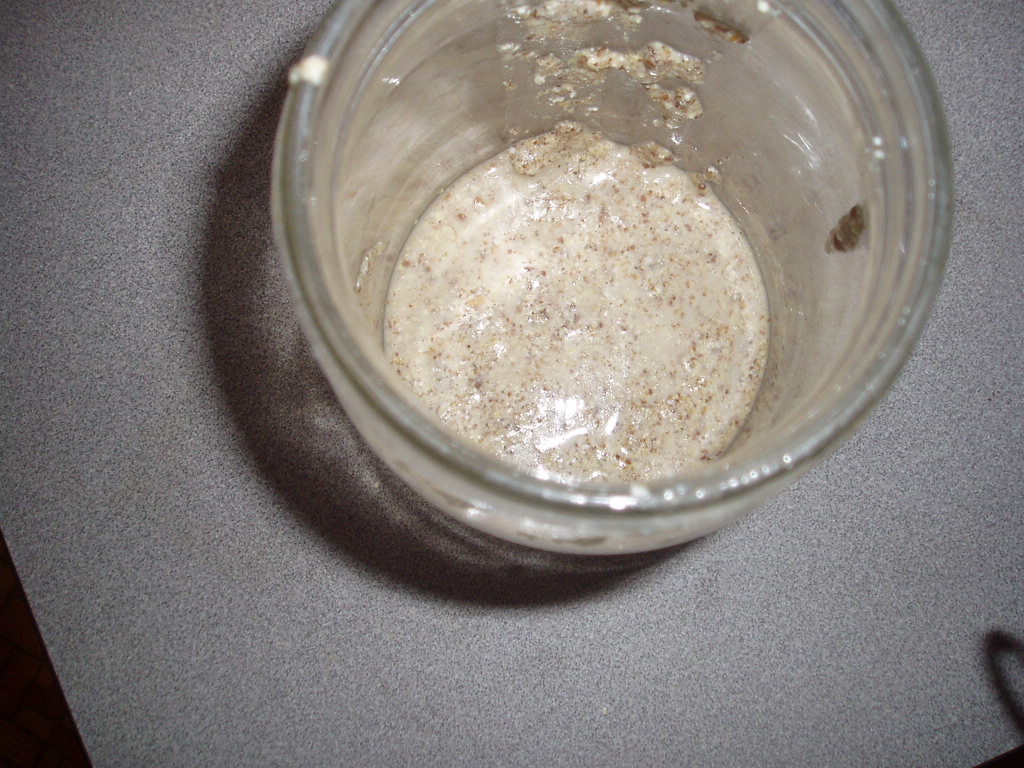 When you have 3 cups of starter worked up you are ready to make bread. You can get this more quickly by feeding larger amounts or more slowly by feeding 1/4 cup a day of quinoa/flax mixed with same amount of water.
When you have 3 cups of starter worked up you are ready to make bread. You can get this more quickly by feeding larger amounts or more slowly by feeding 1/4 cup a day of quinoa/flax mixed with same amount of water.
Add in quinoa, flax, and almond meal. Mix with water, 3 cups starter, salt, and a touch of honey. The mixture will be thick like a batter.
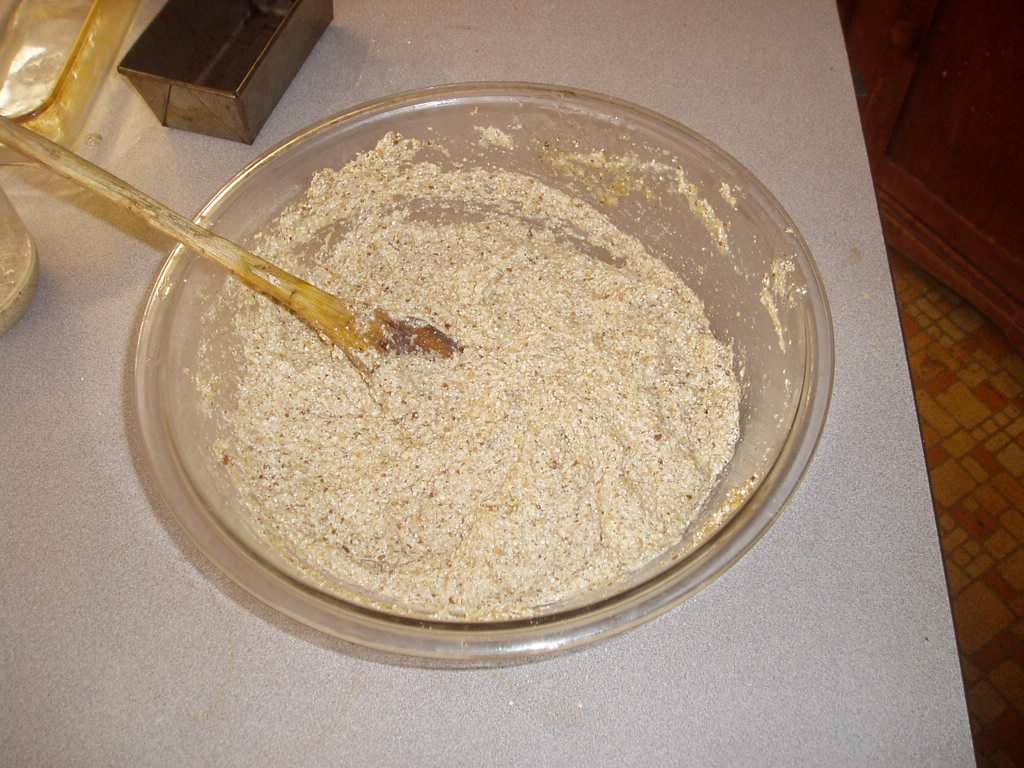 Line your bread pans with parchment paper and scrape the dough into the pans. (I can manage 2 regular pans with this recipe.) Let rise 4-6 hours, up to 12. Dough should be doubled or close to it.
Line your bread pans with parchment paper and scrape the dough into the pans. (I can manage 2 regular pans with this recipe.) Let rise 4-6 hours, up to 12. Dough should be doubled or close to it.
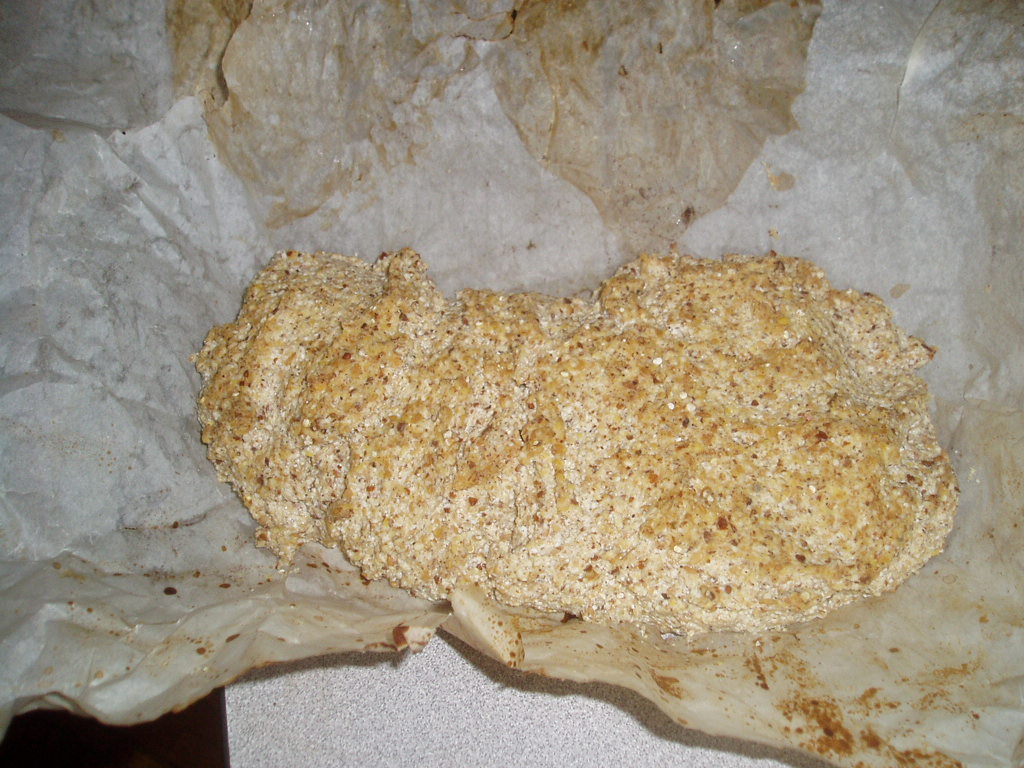
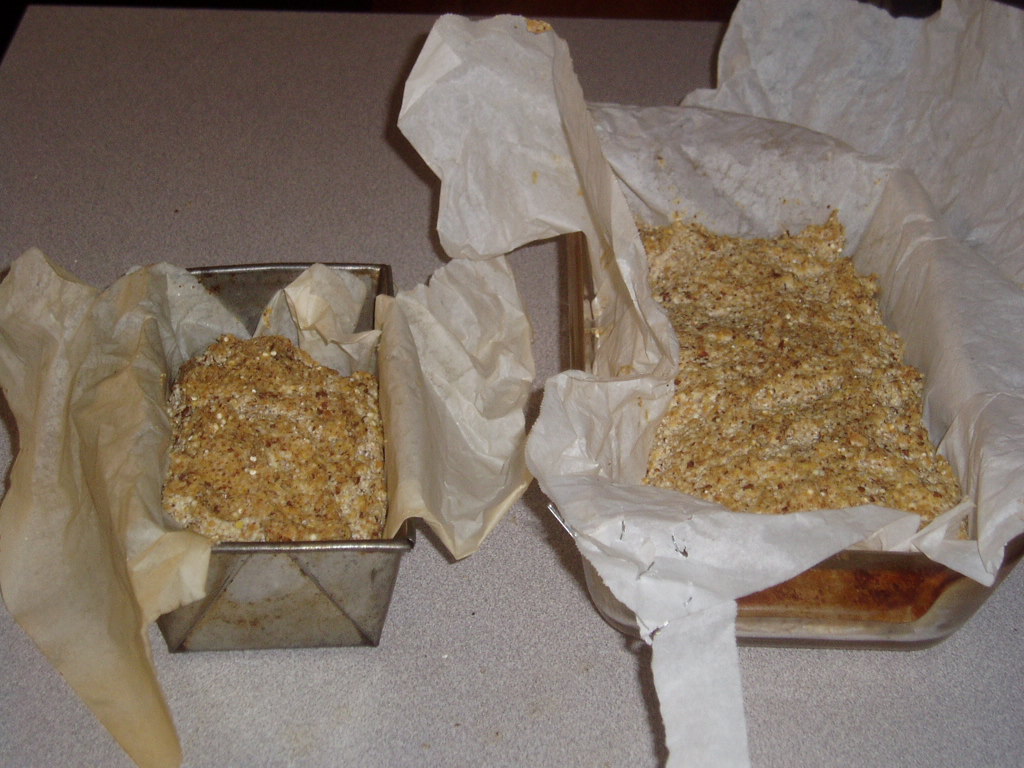
Put your bread into a cold oven. Try to create a Dutch oven kind of effect for baking by putting two bread pans together that are same size. Once the bread is in set it to 400 F.
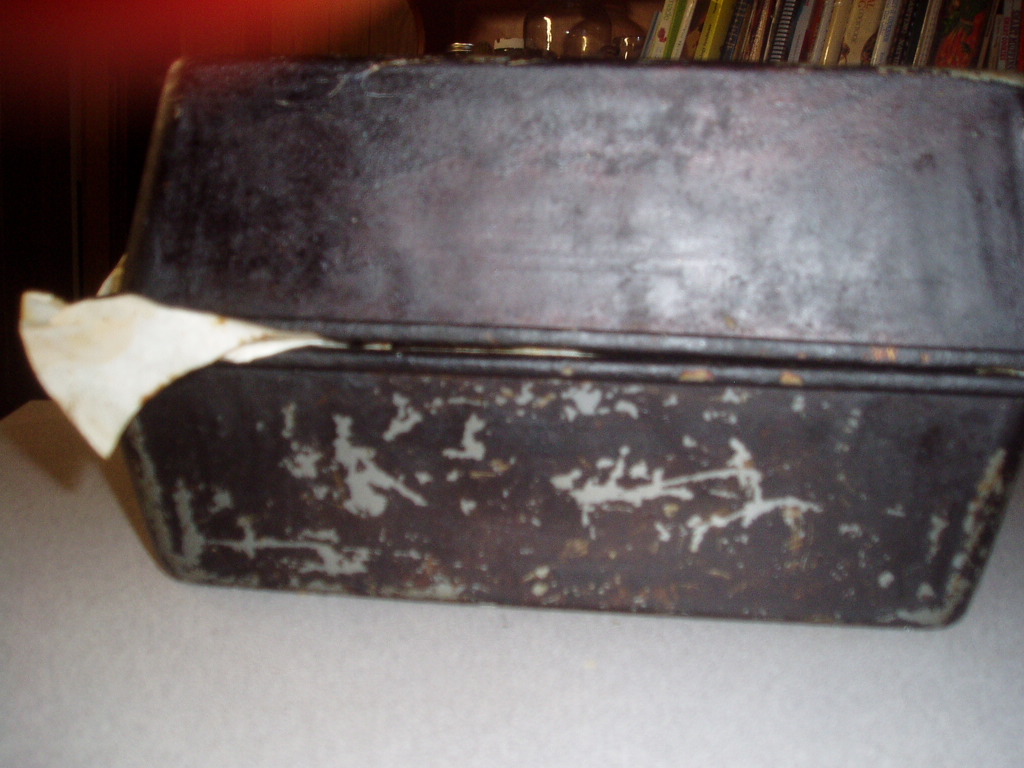 Bake at 40 minutes then uncover for 10-15 minutes until brown. internal temp should be about 200.
Bake at 40 minutes then uncover for 10-15 minutes until brown. internal temp should be about 200.
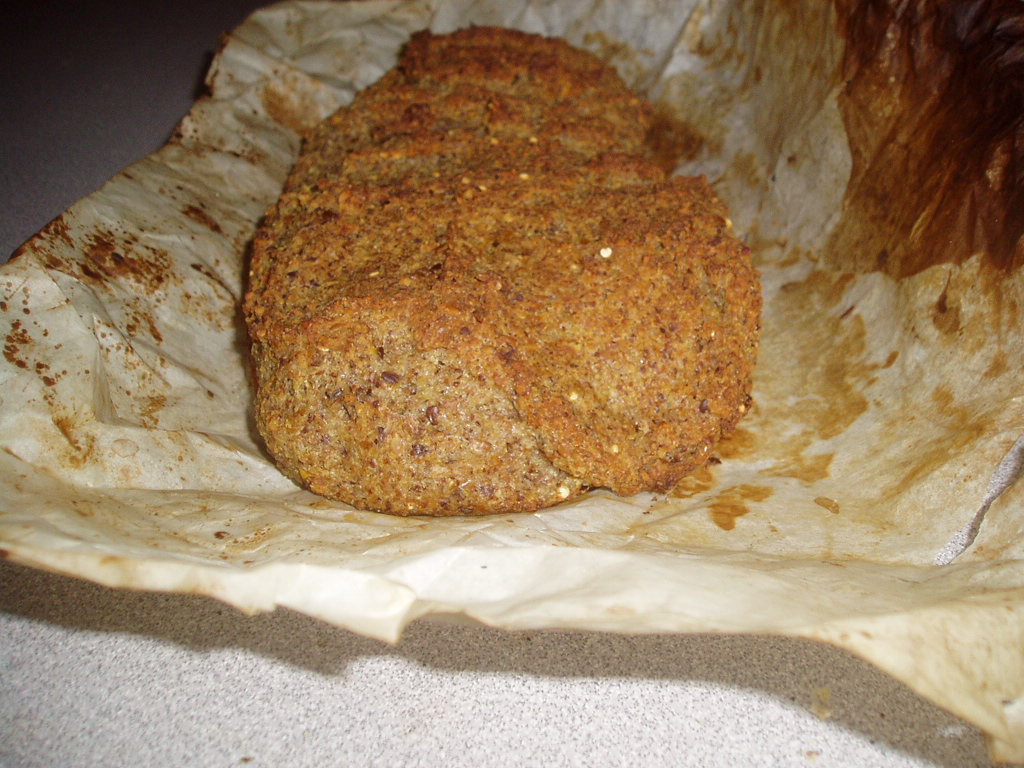 The parchment paper goes with you until the bread has cooled. The dough is very sticky and I don’t think the recipe will work without it.
The parchment paper goes with you until the bread has cooled. The dough is very sticky and I don’t think the recipe will work without it.
- 1 1/2 cups quinoa flour
- 1 cup ground flax
- 1 /2 cup almond flour
- 3 tsp salt
- 1 Tbsp. honey
- 3 cups very active quinoa sourdough starter
- 3/4 cup water (or almond milk to increase protein)
- Mix starter and flours, add liquid 1/4 cup at a time until thick like batter. Mix on high for 3 minutes until smooth.
- Line bread pans with parchment paper, smoothing out wrinkles. Carefully scrape dough into the pans and cover with plastic or cloth. Let rise 4-6 hours (up to 12 hours). Dough should be doubled or close to it.
- Cover pans with another bread pan, some sort of lid, or put into a dutch oven and put into a cold oven. Turn oven temperature to 400 F and bake for 40 minutes. (Do not remove the lid during this time.) Uncover after 40 minutes and bake for 10-15 minutes more until brown but watch for burning. (Internal temperature should be 200 F.)
- Let it set 15 minutes in pan, then transfer to a cooling rack. Cool completely and eat the next day. It will continue to set up overnight and have a better taste and texture the next day.
Shared at Healing With Food Friday, Wellness Wednesday, Simply Natural Saturday, Wildcrafting Wednesday, Weekly Cultured Gathering, Natural Family Friday.

Wow! I need to stock up on quinoa and try this bread. What a great idea 😀
Looks interesting! 🙂
I am just starting to get into fermenting foods, I did not know you could make sour dough bread with quinoa, it is a great option for those avoiding grains. I am wanting to incorporate more real foods into my diet and less processed foods, I might have to try this some time.
I didn’t know that either until my sister in law tried it and it worked so well. It is amazing the amount of things that can be done to improve one’s health and still really enjoy food. Thanks for stopping by. If you try the bread I would love to know how it comes out for you.
Jennifer, Ive been working on my quinoa sourdough starter for 6 days now. I took the cabbage out yesterday and threw it out. The whole bowl smelled horrible–not just a normal fermented sourdough smell. I added a half tablespoon of kombucha and stirred and kept going with instructions. Even with the organic cabbage leaves it doesnt seem to be growing bubbly as quickly as I’ve experienced when making sourdough starter the traditional way. Quinoa flour is expensive; I don’t want to throw it out if I don’t have to. Have I ruined it or should I just keep going for several more days? My health requires a gluten/dairy/soy free lifestyle. I miss great bread and have been looking forward to this one for many reasons.
Thanks for your help! Love your posts!
i would keep working with it another week anyway and see if it is salvageable. It does not grow quickly because it is not glutinous, so it is a tougher sourdough starter to get going. If it does not smell good in a week I would restart or try a different recipe altogether. I hope it works for you.
Hi!
I wanted to circle back with you and let you know that the sourdough starter became very successful for me once I got to the stage of adding flaxseed meal along with the quinoa flour. I made my first two loaves of bread and they look beautiful! They are cooling now; cant wait to try it! Thanks for sharing these unique recipes 🙂
Thanks so much for letting me know. I am so happy to hear that it did end up working out. Enjoy your gluten free sourdough.
I need to work up the courage to try and make my own GF starter. I know I can do it, I’ve just been procrastinating because I felt so defeated when we decided to give up wheat and I let my wheat starter die. 🙁 Thanks for linking up to Wellness Wednesday to inspire me. 🙂 And I dunno how you feel about silicone, but I use a silicone bread pan for all of my eggy and coconut floury bread recipes and it doesn’t stick at all. Love it!
I have a GF starter to post (just waiting for my SIL to confirm that I have the info right as she was the one who started it and not me. I will be linking that up once I publish it also.
And I don’t know how I feel about silicone. It probably is not the best but sometimes you go with the 80/20 rule and figure that falls in the 20%.
Is that really 15 cups of quinoa flour? This looks interesting .
No it is 1. 5 or 1 1/2 cups. I just changed it to 1 1/2 so that there is less chance of confusion. Thanks for asking that question as I don’t want someone to try the bread and really mess it up b/c of a problem with that measurement.
This looks awesome. I will get started on the starter today!! Can you tell me how many carbs are in this bread, either by the slice or whole? My husband is gluten free and also doing low carb as much as possible, but he is craving bread. TIA
I am sorry but I really don’t know the carb count.
I will say though that sourdough bread is always less carbs than the regular b/c the fermentation works some of the sugars out of the grains so I would indulge in some sourdough sparingly but enjoy it. My philosophy is that it is better for long term compliance to make some adaptions and sourdough bread once in a while is one of those.